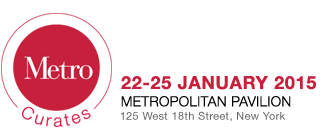Yugen: The Aesthetic of Mystery in Art
 |
The Japanese word yugen means “aesthetically mysterious.” We don’t have a word like this to describe art in the Western art world. Sometimes we look to the Japanese language, which has a finer tuning to the nuances of aesthetics with words like shibui and wabi-sabi. But these are words that describe tangible states of being. Shibui has to do with a simple perfection and wabi-sabi has to do with a rustic sort of imperfection showing impermanence. Yugen as a concept worries some because it describes an intangible. It says “awe” and “mystery” can also be qualitative aesthetics, and the beauty of this is that though yugen is a Japanese word what it describes is universal in reach. Though a refined concept, it is an everyman’s word because it describes perfectly a good deal of the art the entire world makes to achieve personal and cultural satisfaction. In a time when we are 1% and 99% sensitive, let us indeed remember that the art mainstream, the academic discourse, the intellectual game of art about art, the ivory tower is only 1% of why the world makes art. The bad side of this has been that those who do not slavishly follow that 1% of the discourse are severely punished for it. They become relegated to a second tier of artistic importance. Craft. Outsider. Artisan. Rarely Artist.
 |
Collectors and curators are seeing anew. They see the object as a receptacle of spirit and culture as well as formal power. It is an object that steps outside the mainstream narrative and instead engages other concepts than those of the art world. It is not self-referential art for art’s sake. Yugen becomes a way to help describe how we react to the presence of this kind of art. Ephemeral utilitarianism is the bottom line of much of this work even if it is as basic as reminding us to stop our breath in celebration of stillness and the play of light. Yugen teaches us that awe or contemplation is a legitimate way to perceive art. It is not intellectual. All great conceptual craft seeks this place. All authentic self-taught artists occupy this space. It is art that is not separated from living fully and well and beautifully. It is nature. It is place. It is global home ground. It is what Jackson Pollock was getting at when he said, as an artist, “I am nature.”
Art can be elusive in its beauty, and that elusiveness is not only mysterious it is what the artist intended. We are affected by what is not obvious or even necessarily physically present. It is like the way a concert hall feels just after the last note was played and just before the applause. A Christian Burchard basket owns the space around it. Martín Ramírez’s drawings were intended as maps of the soul. A Fang reliquary was an actual mediator between man and ancestor. The work triggers a yearning to make life that cohesive.
Yugen allows. Yugen opens gates. It is a bridge between artist and viewer. It breathes space into perception with a heady flavor. Silence becomes part of the works’ music. Yugen allows us to look for “essence.” It absorbs process at the same time it celebrates it. Process becomes the means to the end, no matter how elaborate or time consuming. Process is the interaction of artist with muse.
 |
Our perception of the world has dramatically changed in the last decade. The cerebral aspects of art need supplement. We finally acknowledge that other things are needed to satisfy us. The art of the global home ground reflects concerns that have nothing to do with post modernism. It is art about how we can survive naturally as part of the world not above it or removed but from deep inside it. The things we make reverberate with near unspeakable profundity. They are utilitarian in that they serve the purposes of the home ground; didacticism, a dialog with nature, a preservation of cultural history, a mode of mediation with ancestors, a potential gateway to contemplative peace, a way of cultural resistance. Art becomes part of our internal and external landscapes. The process is the process of living. It is how we survive.
Yugen is the mantle of minimalism and abstraction. It is the emotion and the power of what communicates after all excess has been cut away that is not necessary for that communication. Can trained artists communicate this? Of course they can, Agnes Martin, Cy Twombly, Jackson Pollock, Anselm Kiefer, Jean-Michel Basquiat. The ones that seem to do it best are the ones who are iconoclasts to the mainstream. Who travel alone. They broke free from the discourse with a raw connection to the muse and at least a touch of genius. These are all human, creative endeavors; why are there these stifling hierarchies of seemingly moral values that made a painting—just because of the word “painting,”—high art and a sublime work by Chizu Sekiguchi or Yagi Kazuo craft? Why is John McQueen’s work relegated to studio craft and not Sol LeWitt’s or Richard Serra’s? Why is any of it different form a Dogon Tellem figure or a Kongo nkisi? Why was such a category as “outsider art” created to keep the work of visionaries from the mainstream? What about Aboriginal painting being the first majorly recognized body of contemporary art that isn’t Western?
The art I am talking about is art imbued with meaning that comes from a cultural place. An Everald Brown dove harp is not “about” religion, it is religion. A chawan contains a world in its well. A Tim Rowan sculpture is landscape realized, not landscape depicted. And without yugen, without words that describe intangible, indefinable, yet humanly essential themes, without a language of mystery, without accepting mystery as a fulfilling goal in and of itself, without understanding the evocative, we will never unify the tiny island of Mainstream Art and the way almost all of the world actually makes art in what we now call the Ethnosphere.






 The name "Larsen" is synonymous with 20th century textiles. Ever since Jack Lenor Larsen, Inc. was established in 1952, the influence of its innovative, farseeing founder has permeated the field of interior design. Ranging from filmy casement cloths to plush upholstery, from the formal geometry of complex doubleweave to the freshness of colorful organic prints, Larsen textiles have enhanced walls and floors of large company headquarters, educational institutions, jet planes, and private homes.
The name "Larsen" is synonymous with 20th century textiles. Ever since Jack Lenor Larsen, Inc. was established in 1952, the influence of its innovative, farseeing founder has permeated the field of interior design. Ranging from filmy casement cloths to plush upholstery, from the formal geometry of complex doubleweave to the freshness of colorful organic prints, Larsen textiles have enhanced walls and floors of large company headquarters, educational institutions, jet planes, and private homes.